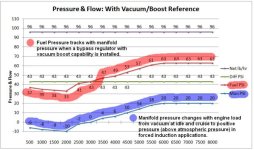Is this why FP varies along with the MP?
Like Matt showed earlier, I too noticed that the FP varies with the MP.
Then it got me thinking, as Dan says, why??
I understand Ross' explanation to the FPR being overwhelmed and not "opening" enough when 2 pumps are working.
I have 1 pump working at a time.
I measured my (free) flow to be 50 USG/hour.
At startup, engine not running, I have 35.6 PSI
Aeromotive FPR
Fuel Pressure Sensor connected to Regulator.
The pump just pumps... it pressurizes the rail, doesn't care how much fuel the injectors take.
When the fuel demand is high, the regulator keeps the pressure up by "closing" thus less flow to the return line??
When it's low, the regulator "opens" allowing the surplus pressure to flow more freely to the return line??
Does the pressure in the rail stay more or less the same at high or low power??
Is the varying FP shown on our instruments due to the physical placement of that fuel pressure line to the sensor when the regulator is moving more or less fuel to the return line??
At 29,5 MP = 34,6 PSI FP
At 6,1 MP = 23,5 PSI FP
Like Matt showed earlier, I too noticed that the FP varies with the MP.
Then it got me thinking, as Dan says, why??
I understand Ross' explanation to the FPR being overwhelmed and not "opening" enough when 2 pumps are working.
I have 1 pump working at a time.
I measured my (free) flow to be 50 USG/hour.
At startup, engine not running, I have 35.6 PSI
Aeromotive FPR
Fuel Pressure Sensor connected to Regulator.
The pump just pumps... it pressurizes the rail, doesn't care how much fuel the injectors take.
When the fuel demand is high, the regulator keeps the pressure up by "closing" thus less flow to the return line??
When it's low, the regulator "opens" allowing the surplus pressure to flow more freely to the return line??
Does the pressure in the rail stay more or less the same at high or low power??
Is the varying FP shown on our instruments due to the physical placement of that fuel pressure line to the sensor when the regulator is moving more or less fuel to the return line??
At 29,5 MP = 34,6 PSI FP
At 6,1 MP = 23,5 PSI FP








